Snuffy Jenkins
and
Pappy Sherrill
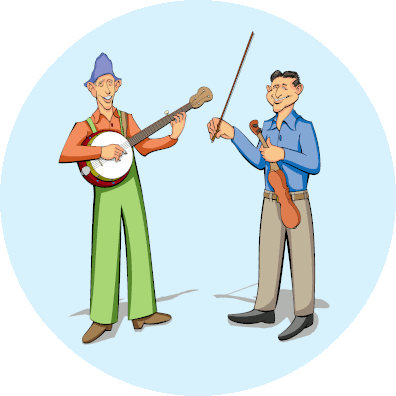
(Click on the image to zoom in.)
When you see lists of
The
 GREATEST
GREATEST
COUNTRY SINGERS
of
ALL TIME
... then in addition to individual artists like Johnny Cash, June Carter Cash, Loretta Lynn, Conway Twitty, Merle Travis, Patsy Cline, Dolly Parton, Kitty Wells, and Hank Williams Sr., you'll also see groups like the Carter Family, Bob Willis and the Texas Playboys, Bill Monroe and the Bluegrass Boys, Earl Scruggs and Lester Flatt and the Foggy Mountain Boys, The Stanley Brothers, and even Merle Haggard and the Strangers and Buck Owens and the Buckeroos.
But never in any of the Lists of the Greatest Country Singers will you find an iota, jot, or tittle of
 Snuffy Jenkins
Snuffy Jenkins
and
Pappy Sherrill
The Greatest of the Greatests
(According to the Lists)
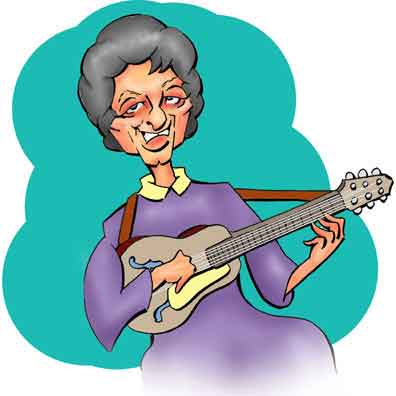
Maybelle Carter

Merle Haggard
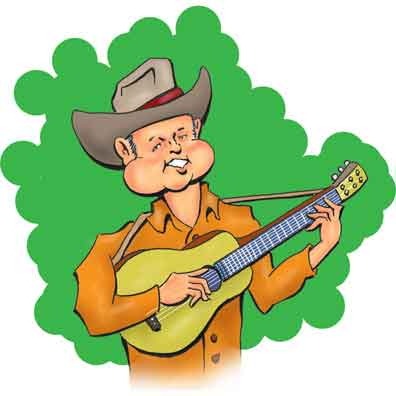
Merle Travis
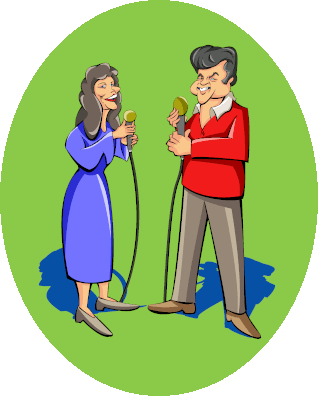
Loretta Lynn and Conway Twitty
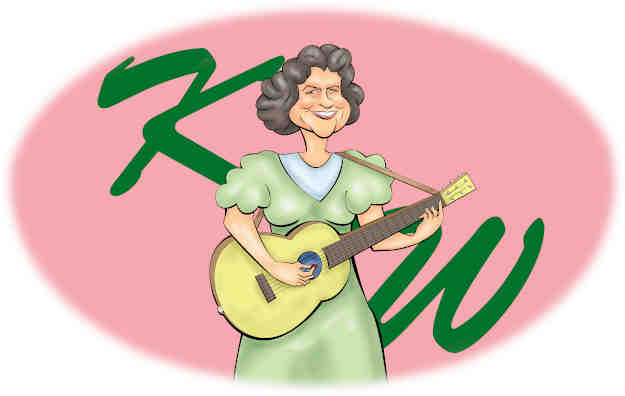
Kitty Wells
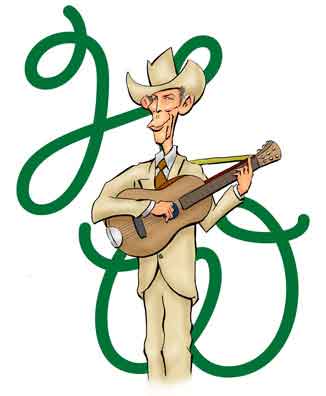
Hank Williams
And just who are Snuffy Jenkins and Pappy Sherrill of whom there is this maintenance of a neglected but justly deserved hagiography?
Snuffy and Pappy - whose real names were Dewitt and Homer - were born in the region of North Carolina called the Piedmont Plateau. The Piedmont - like all plateau regions - are not strictly speaking mountains. Generally the landforms are, if not actually flat, then gently rolling. So if you see something that looks like mountains you're probably seeing higher elevations surrounded by valleys that were carved out by erosion. To get to the true mountains of North Carolina you have to move further west to the Blue Ridge.
Today people read about the time that Snuffy and Pappy were born - 1908 to 1915 - and wonder, just what the heck did everyone do for entertainment? There was no television, no movies, no electronic games. What could you do?
Actually, there was stuff to do. Many towns generally had a theater or "opera" house where traveling theater companies would put on plays. Sometimes a famous writer might stop in the town and give lectures. And once a year a circus might roll into town.
But as far as regular entertainment it's not too far from the truth that you had two options. You went to church or you went to a square dance.
Like church services the square dances were held at least once a week. Although sometimes people would gather at a private home, pull back the rug, and do some high stepping, usually you needed more room than a typical living room would provide. So most towns, even small ones, had "dance halls" or "road houses" which had a room large enough to accommodate the dancers plus a stage or platform for the band and the caller. Some dance halls had kitchen facilities or if not, people would bring dishes and set them on tables lined along one side of the room. Dance halls, although not as common today as they were then, are still around.
But whether it was a church service or a dance, music was necessarily a part of the entertainment. Equally necessarily the music had to be live music. So skilled musicians, vocal and instrumentalists both, were in high demand.
But unlike church services, the early 20th century square dances were liquor-fueled soirées where disputes often produced considerable Sturm und Drang. If the news stories are to be believed it wasn't just the menfolk that became cantankerous. Things got so fractious - fueled not just by hooch but Prohibition's unsavory bootleg hooch - that when folklorist Alan Lomax visited the Appalachians as a young man, square dancing had virtually disappeared from the region because so many people had been killed - if we may quote Alan - "during jealous, drunken quarrels at these Saturday night blowouts".
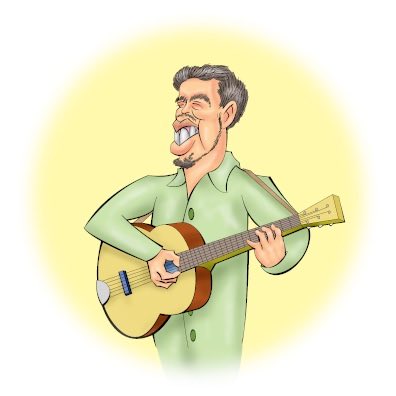
Alan Lomax
Appalachian Visitor
But the times - as a Nobel Prize winner once wrote - were a-changing. Once the Twenties roared in, America began undergoing the first of the many cultural and technology revolutions that peppered the century. Arguably the decades from 1910 to 1930 brought in more changes to America's mores and lifestyles than did the years of the Digital and Information Revolution of the 1980's to 2000.
For one thing electricity had begun reaching to the hedges and highways, and with it a new type of theater intended for that new fangled sedentary entertainment called motion pictures. Unlike today the movie theaters in the early 20th century still had a stage or raised platform with the screen on the wall above it. This design (which lasted into the 1970's) could accommodate live performers who were often brought in as promotional extras. And if for some reason the scheduled movie was delayed en route, an entirely live performance - often a group of local musicians - could be substituted in its stead.
But beginning around 1920 another and even more revolutionary form of entertainment was literally invading the homes. That was radio. Although for your average family the capital outlay was by no means cheap - in 1925 a radio set could easily cost $100 - you could enjoy a full evening's entertainment while relaxing in your front parlor. For listeners without electricity battery powered models were available. And then as now among the most popular programs were those with music.
The cumulative effect of these sociological and technological metamorphoses was that when Snuffy and Pappy began performing in the late 20's and early 30's, more and more music was being played purely for the listening pleasure of a sit-down audience. So the tempos of the moderately paced dancing tunes could now be upped to breakneck speeds where the individual musicians could step forward and display their virtuosity.
We said Pappy was born in 1915, but exactly where is a bit confusticated because one source might say he was born "near" Hickory, North Carolina and others state it was a bit further east at Sherrills Ford. Certainly Pappy could trace his ancestry back to the pioneer Adam Sherrill who in 1747 became the first European to settle west of the Catawba River. Once at the banks Adam managed to find a shallow area suitable for fording and hence the name. Sadly for history buffs who like to scout out original landforms and locations, the original Sherrills Ford was goobered up by the creation of Lake Norman which makes the nearby city of Charlotte a center of regional outdoor recreation.
So it's best just to say that Pappy was born not far from Charlotte. He learned to fiddle early - his first "violin" cost a whopping $1.98 - and he'd sit around and play music while his dad sold watermelons. Evidently Pappy's fiddling was a good draw since they'd sell everything by noon while the other farmers were still loaded up with produce.
Pappy's skill was clearly a cut above the usual aspiring musicians of his tender years. By the time he was thirteen, he was playing on the radio and before he turned 20, he was a prominent performer on Charlotte's Crazy Water Barn Dance broadcast from Station WBT. With a population of 80,000, Charlotte was a major metropolitan area by any meaning of the words and so a radio station with a "Barn Dance" wasn't unusual. Chicago's National Barn Dance on Station WLS was the longest lived of the genre and began broadcasting in 1924 and didn't wind up until near the end of the 60's.
Like many professional musicians, Pappy performed with a number of groups whose membership was by necessity rather fluid. Then in 1939 a popular radio announcer and musician named Byron Parker asked Pappy to move with his family to Columbia, South Carolina. Byron had a daily radio program on Station WIS which featured his band. Appearing on a daily program would provide Pappy not only with steady employment but was also great publicity for public appearances.
Byron always signed off as "your old hired hand" and so the band was variously dubbed as Byron Parker (The Old Hired Hand) and the Mountaineers or Byron Parker (The Old Hired Hand) and His Hillbillies. Whatever the name, the group became one of the most popular bands in the state and when Byron died suddenly in 1948, the others decided to rename the group The Hired Hands in his honor.
The banjo player of The Mountaineers, The Hillbillies, or The Hired Hands was Dewitt Jenkins. Born in Harris, North Carolina, about 50 miles due west of Charlotte and a hop, skip, and a jump - less than five miles - north of the South Carolina border, Dewitt also showed musical talent early when he and his fiddling brother Vern began entering and winning local fiddling contests.
By the mid-1930's Dewitt Jenkins was the leader of a "string band" commensensically called Dewitt Jenkins' Stringband who were also regulars on WBT’s Crazy Water Barn Dance. But Snuffy - so dubbed by Byron - seemed to prefer the role as a sideman and comedian and soon joined The Mountaineers. These Mountaineers, though, weren't Byron's Mountaineers but instead was the eponymous group led by fiddler Joseph Emmett Mainer, known as J. E. to his friends.
In J. E.'s Mountaineers, Snuffy played banjo but not in the traditional and usual "frailing" or "clawhammer" technique where the strings are struck with a downward motion with either the thumb or the back of the finger. Instead Snuffy used a downward stroke only with the thumb and he plucked upwards with his fingers. For greater volume and a cleaner sound, he wore finger picks.
Here a slight digression is needed. It's no coincidence that Earl Scruggs who became famous for his three-finger "Scruggs style" banjo picking was also from western North Carolina. Earl was born in 1924 in Flint Hill about 50 miles west of Charlotte and so was 10 years old when Pappy and Snuffy began performing on the radio.
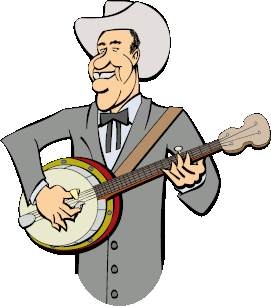
Earl Scruggs
No Coincidence
For some reason, many banjoists living along Carolina's western Piedmont preferred the "up-picking" rather than clawhammer. In the early years, the most common up-picking technique was simply to use the thumb on the downstroke and the index finger for the upstroke. The little and ring finger rested on the banjo head to stabilize the hand. When he first began playing, Earl used this two-finger style.
Up picking sounded the individual notes more crisply than clawhammer playing which produced a plunkier tone where intentionally or not multiple strings were often struck simultaneously. Up-picking was louder and well suited for playing with an ensemble as well as for displaying the player's virtuosity.
Of course picking with the thumb and index finger and anchoring the hand with the little and ring finger, left el dedo medio dangling around without much to do. So in the Carolinas some of the mountain banjoists began using this neglected digit to assist the index. The first of these "three-finger" pickers to play on the radio and record was Charlie Poole.
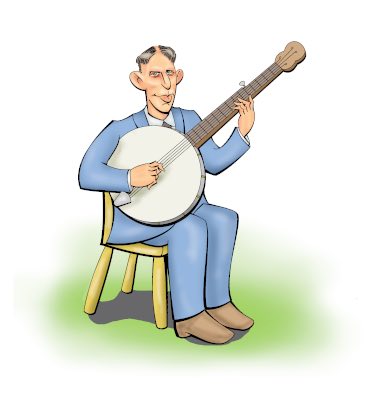
Charlie Poole
Neglected Pioneer
Charlie is one of the true pioneers of country music and he, too, is almost always left off the "Greatest Country Musicians" lists. He began performing around 1917, dividing his time between working in the textile mills and performing with The North Carolina Ramblers. In 1925 he traveled to New York to make his first recordings, and in the next few years, Charlie and the Ramblers achieved considerable fame. Then in 1931 they were scheduled to make a movie in Hollywood when Charlie died of a heart attack at age 39.
However, it's important to note that the modern listener will not readily recognize Charlie's style as anything distinct from old timey playing and it's not easy to tell he's actually using three finger picking. Instead, some authors maintain it was Snuffy who in 1934 became the first person to play true three-finger banjo on the radio.
Neither Snuffy nor Earl Scruggs claimed to have invented modern three-finger picking. Instead both credited the technique to a banjo player named Smith Hammett. Smith was in fact a neighbor to the Scruggs family and the two families visited each other frequently. When he was young Earl found it was easier to play one of Smith's smaller banjos rather than the full sized instrument owned by the oldest Scruggs brother, Junius.
Earl began playing three finger style unconsciously. He was practicing a song in his usual thumb-index picking when he noticed he was using his middle finger to pluck the strings as well. He said he practiced that song repeatedly for a week. Then he ran to his mom shouting, "I can play like Smith Hammett! I can play like Smith Hammett!" For his part Snuffy said that even though he couldn't definitely say that Smith was the first banjoist to play the three finger style, he was the first that Snuffy ever heard play that way.
Here another digression is in order. If the non-cognoscenti see a band with guitar, fiddle, and banjo, they'll likely call it a bluegrass band. That, though, is not strictly speaking or necessarily correct.
The invention of bluegrass music is largely credited to Bill Monroe who around 1938 with his brother Charlie began playing music that was distinct from the earlier "string band" music. Although Bill and Charlie would play slower tunes songs - waltzes were part of their repertoire - many of their tunes were decidedly faster than traditional old timey hoedowns. The songs - much like those of Chicago jazz - would kick off with everyone playing togethr but would include "breaks" with the specific intent of demonstrating the individual players' skill.
It's hard to find readily accessible recordings of Byron, Snuffy, and Pappy before World War II. Some of their early songs are clearly in the old timey style even though Snuffy is playing "modern" three-finger picking. His banjo solos, though, are relatively brief and not particularly flashy.
However around 1940, The Mountaineers began playing tunes that if not actually bluegrass were, as one scholar pointed out, getting pretty darn close. The tempos are faster than before and Snuffy's banjo playing is more prominent.
Musical Links
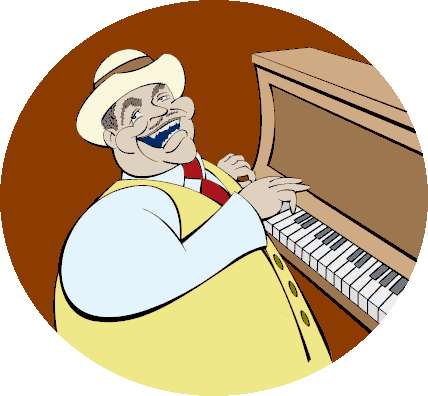
Fats Waller
Ragtime to Jazz

Bo Diddley
Blues to Rock
Certainly to the layman ears, on these later songs Snuffy's picking sounds like bluegrass. Today scholarly opinion recognizes Snuffy as one of the links between old timey music and bluegrass much as Fats Waller tied ragtime to jazz and as Bo Diddley did with blues and rock and roll.
Although bluegrass music without a three-finger banjo is now a virtual contradiction, it's worth noting that in 1940 when Snuffy was playing what by any definition of the word is bluegrass, Bill Monroe didn't even have a banjo player. It wasn't until 1942 that Bill hired David "Stringbean" Akeman. String, though, played the traditional old timey clawhammer style. It was only in 1945 that Earl Scruggs joined Bill and his band which ended up being called The Bluegrass Boys.
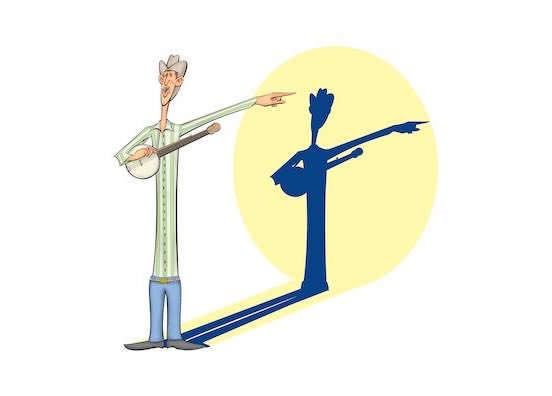
Stringbean Akeman
Traditional
(Click on image to
zoom in and out).
The Hired Hands remained popular in the Carolinas throughout the 1950's, and they even they had their own television show Carolina in the Morning that was aired when WIS opened a television station. Then as the Swinging 60's rolled in Snuffy, Pappy, and the others found themselves in demand to young urban listeners at the folk and bluegrass festivals that began popping up just about everywhere.
It's true The Hired Hands never received the one accolade of the likes of Peggy Fleming, Helen Reddy, Jodie Foster, Cab Calloway, Carol Channing, Billy Dee Williams, Nicole Kidman, Herbie Hancock, Tony Bennett, Crystal Gayle, Harry Belafonte, James Taylor, Linda Ronstadt, Jay Leno, Cher, Whitman Mayo, Jim Nabors, Al Roker, Walt Frazier, Rosemary Clooney, Alison Krauss, Tim Conway, Bo Jackson, Stevie Wonder, Johnny Cash, Waylon Jennings, B.B. King, Dizzy Gillespie, Loretta Lynn, Ray Charles, Carly Simon, Mahalia Jackson, Pete Seeger, and Kermit the Frog. No, the Hired Hands never appeared on Sesame Street, and so never reached the 20th Century's highest pinnacle of celebrity.
The did, though, come pretty close. On November 17, 1984, The Hired Hands appeared on the stage which saw the likes of Pyotr Tchaikovsky, Fritz Kreisler, Pablo Casals, Sergei Rachmaninoff, Jascha Heifetz, Enrico Caruso, Igor Stravinsky, Luciano Pavarotti, Maria Callas, Glenn Gould, Van Cliburn, Arturo Toscanini, Leonard Bernstein, and Andrés Segovia.
Yes, The Hired Hands played at Carnegie Hall.
References and Further Reading
"100 Greatest Country Artists of All Time", David Browne, Jon Dolan, Jon Freeman, Chris Parton, Stephen L. Betts, Andrew Leahey, Joseph Hudak, Kory Grow, Marissa R. Moss, Maura Johnston, Joe Levy, Will Hermes, David Cantwell, Jonathan Bernstein, Alan Light, Rolling Stone, June 27, 2008.
"Sherrill, Homer Lee", South Carolina Encyclopedia.
"Jenkins, Dewitt", South Carolina Encyclopedia.
"Country Music", South Carolina Encyclopedia.
"Poole, Charlie Clay", Clifford Kinney Rorrer (Author), William S. Powell (Editor), Dictionary of North Carolina Biography, 1979 - 1996, (Article reprinted on NCPedia).
"South Carolina's Homer Lee 'Pappy' Sherrill", Pat Ahrens, Fiddler Magazine, March 1, 2001.
"Homer 'Pappy' Sherrill", Preserving South Carolina's Fiddling Traditions.
"Snuffy Jenkins and Pappy Sherrill", History South.
"Roots of Earl and Snuffy", Bob Carlin, Remember Cliffside.
"Snuffy Jenkins", Wilkes Heritage Museum (Reprinted in Banjo Reserve).
Earl Scruggs and the Five String Banjo, Earl Scruggs, Peer Southern Publications, 1980.
"Earl Scruggs and the 3-Finger Banjo Style", Bob Carlin, Banjo Newsletter, November, 2006.
"Banjo Groundbreakers", Michael Hofer, History of Banjos.
Folk Songs of North America, Alan Lomax, Doubleday, 1960.
The Dictionary of Global Culture, Anthony Appiah, Kwame Anthony Appiah, and Henry Louis Gates, Knopf, 1996.
"Snuffy Jenkins", Discogs.
"Pappy Sherrill", Discogs.
"Homer Sherrill", Discogs.
"American Folk Roots: Southern Mountain Music", Glen Hinson (Host), The Hired Hands (Band), Carnegie Hall, November 17, 1984.
"Goldsborough Gossip - Correspondence of the Messenger ", [Goldsborough , North Carolina] Semi-weekly Messenger, August 31, 1900, p. 3, Chronicling America, Library of Congress.
"Murdered - But Alive", Watauga [North Carolina] Democrat, January 24, 1929, Chronicling America, p. 3, Library of Congress.
"Lulu Anderson Gives Bond", [Salisbury, North] Carolina Watchman, June 6, 1917, p. 5,Chronicling America, Library of Congress.
"Five Killed in Explosion", The [Clinton, North Carolina] Caucasian, February 21, 1907, p. 5,Chronicling America, Library of Congress.
"Woman Slayer Still Sought by Officers", Hickory [North Carolina], Daily Record, June 1, 1917, p. 3,Chronicling America, Library of Congress.